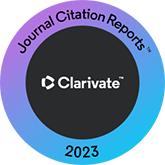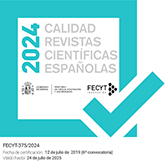Voices in audiodescription: Neutrality and pleasantness
DOI:
https://doi.org/10.3989/loquens.2020.076Keywords:
audiodescripción, prosodia, usuarios con pérdida de visión, percepciónAbstract
The aim of this study is to analyse the prosodic features of a corpus of audio descriptions in Spanish in order to determine the neutrality and the pleasantness in the prosody used by the speakers. The analysis involves a revision of the recommendations found in guidelines and standards on the voices of the audio describers. According to the Spanish standard by Asociación Española de Normalización (UNE 153020), speech in audio description (AD) must be neutral, and emotional intonation should be avoided.
The corpus is obtained from professional male and female speakers. The duration, pitch and amplitude of AD units have been analysed. Then, a perception test has been carried out to assess the neutrality of the voices of the describers, which were chosen by means of an acoustic analysis, and the relationship between neutrality and pleasantness. Perception tests results were analysed taking into account two separate groups: on the one hand, persons with sight loss and, on the other hand, persons without sight loss. The results of this study can help to better select audio description voices depending on the specific task to be performed and can also help to identify differences depending on the user profile.
Downloads
References
AENOR. (2005). Norma UNE:153030. Audiodescripción para personas con discapacidad visual. Requisitos para la audiodescripción y elaboración de audioguías. Madrid: AENOR.
Alter, K. (2002). Suprasegmentale Merkmale und Prosodie, En H. M. Müller (Ed.), Arbeitsbuch Linguistik (pp.148-169). Paderborn: UTB-Ferdinand Schöning.
Banse, R. y Scherer, K. R. (1996). Acoustic profiles in vocal emotion expression. Journal of Personality and Social Psychology, 70(3), 614-636. https://doi.org/10.1037/0022-3514.70.3.614 PMid:8851745
Boersma, P. y Weenik, D. (2019). Praat: Doing Phonetics by Computer [Computer program]. Electronic version: <http://www.praat.org>
Cabeza-Cáceres, C. (2013). Audiodescripció i recepció. Efecte de la velocitat de narració, l'entonació i l'explicitació en la comprensió fílmica. Barcelona: TDX. Versión electrónica: https://www.tdx.cat/handle/10803/113556
Crystal, D. (2008). A Dictionary of Linguistics and Phonetics. Oxford: Blackwell (6.ª edición). https://doi.org/10.1002/9781444302776
Gougoux, F., Belin, P., Voss P, Lepore, F., Lassonde, M. y Zatorre, R.J. (2009). Voice perception in blind persons: A functional magnetic resonance imaging study. Neuropsychologia, 47, 2967-2974. https://doi.org/10.1016/j.neuropsychologia.2009.06.027 PMid:19576235
Gougoux, F., Lepore, F., Lassonde, M., Voss, P., Zatorre, R. J. y Belin, P. (2004). Neuropsychology: Pitch discrimination in the early blind. Nature, 430, 309. https://doi.org/10.1038/430309a PMid:15254527
Hidalgo Navarro, A. (2017). Nuevas aportaciones al estudio funcional de la entonación coloquial: propuesta ecléctica de integración de modelos de análisis. Estudios Filológicos, 60, 127-150. https://doi.org/10.4067/S0071-17132017000200006
Iglesias Fernández, E. (2006). La indefinición del parámetro "agradabilidad de la voz" y los estudios de calidad de la interpretación simultánea. En M. J. Varela Salinas (Coord.), La evaluación en los estudios de traducción e interpretación (pp. 225-239). Sevilla: Bienza.
Iglesias Fernández, E. (2013). Understanding variability in interpreting quality assessment: user's sex and judgements for pleasant voice. En C. Way, S. Vandepitte https://doi.org/10.1075/btl.108.06igl
R. Meylaerts y M. Bartłomiejczyk (Eds.), Tracks and Treks in Translation Studies: Selected Papers from the EST Congress, Leuven 2010 (pp. 103-125). Amsterdam: John Benjamins.
Kraxenberger, M. et al. (2018). Prosody-Based Sound-Emotion Associations in Poetry. Frontiers in Psychology. https://doi.org/10.3389/fpsyg.2018.01284 PMid:30090078 PMCid:PMC6068276
Machuca, M. J., Matamala, A. y Ríos, A. (2020). Prosodic features in Spanish audio descriptions of the VIW corpus. En M. Richart-Marset y F. Calamita (Eds.), Traducción y accesibilidad en los medios de comunicación: de la teoría a la práctica / Translation and Media Accessibility: From Theory to Practice. MonTI 12, (en prensa). https://doi.org/10.6035/MonTI.2020.12.02
Matamala, A. (2018). One short film, different audio descriptions. Analysing the language of audio descriptions created by students and professionals. Onomazéin, 41, 185-207. https://doi.org/10.7764/onomazein.41.04
Matamala, A. (2019). Accessibilitat i traducció audiovisual. Vic: Eumo.
Matamala, A. y Villegas, M. (2016). Building an audio description multilingual multimodal corpus: the VIW project. En J. Edlund, D. Heylen y P. Paggio (Eds.) Proceedings: Multimodal Corpora: Computer vision and Language processing- MMC2016 (pp. 29-32). Paris: ELRA. Electronic version: <http://www.lrec-conf.org/proceedings/lrec2016/workshops/LREC2016Workshop-MCC-2016-proceedings.pdf>
Pell, M. D., Paulmann, S., Dara, C., Alasseri, A. y Kotz, S. A. (2009). Factors in the recognition of vocally expressed emotions: a comparison of four languages. Journal of Phonetics, 37, 417-435. https://doi.org/10.1016/j.wocn.2009.07.005
Podsiadło, M. y Shweta, Ch. (2016). Text-to-Speech for Individuals with Vision Loss: A User Study. 347-351. https://doi.org/10.21437/Interspeech.2016-1376
Rodero, E. (2001). Locución informativa radiofónica. Tesis doctoral. Universidad Pontificia de Salamanca.
Rodero, E. (2002). El tono de la voz masculina y femenina en los informativos radiofónicos: un análisis comparativo. En Mujeres, Hombres y Medios de Comunicación (pp. 319-331). Madrid: Lex Nova
Rodríguez Bravo, A. (1989). La construcción de una voz radiogénica. Tesis doctoral. Universitat Autònoma de Barcelona
Scherer, K. R. (1986). Vocal affect expression: A review and a model for future research. Psychological Bulletin, 99, 143. https://doi.org/10.1037/0033-2909.99.2.143
Scherer, K. R. (2013). Emotion in action, interaction, music, and speech. En A. A. Micheal (Ed.), Language, Music, and the Brain: A Mysterious Relationship (pp. 107-139). Cambridge: MIT Press. https://doi.org/10.7551/mitpress/9780262018104.003.0005 PMid:23890120
Stolarski, Ł. (2015). Pitch patterns in vocal expression of "Happiness" and "Sadness" in the reading aloud of prose on the basis of selected audiobooks. Research in Language, 13, 141-162. https://doi.org/10.1515/rela-2015-0016
Ververidis, D. y Kotropoulos, C (2006). Emotional speech recognition: resources, features, and methods. Speech Communication, 48(9), 1162-1181 https://doi.org/10.1016/j.specom.2006.04.003
Published
How to Cite
Issue
Section
License
Copyright (c) 2021 Consejo Superior de Investigaciones Científicas (CSIC)

This work is licensed under a Creative Commons Attribution 4.0 International License.
© CSIC. Manuscripts published in both the print and online versions of this journal are the property of the Consejo Superior de Investigaciones Científicas, and quoting this source is a requirement for any partial or full reproduction.
All contents of this electronic edition, except where otherwise noted, are distributed under a Creative Commons Attribution 4.0 International (CC BY 4.0) licence. You may read the basic information and the legal text of the licence. The indication of the CC BY 4.0 licence must be expressly stated in this way when necessary.
Self-archiving in repositories, personal webpages or similar, of any version other than the final version of the work produced by the publisher, is not allowed.
Funding data
Ministerio de Economía y Competitividad
Grant numbers PGC2018-096566-B-I00
Generalitat de Catalunya
Grant numbers 2017SGR113














